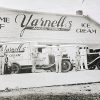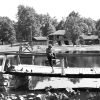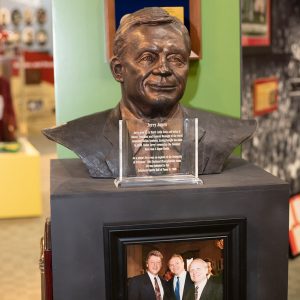calsfoundation@cals.org
Jerry Jones (1942–)
Jerry Jones, the owner of the Dallas Cowboys, is one of the most influential, if controversial, figures in modern professional sports. His stewardship of “America’s Team” and his contributions to the rise of the National Football League (NFL) to the undisputed top of the professional sports ladder have given him one of the highest public profiles an owner has ever had, as well as enshrinement in the Pro Football Hall of Fame.
Jerral Wayne Jones was born on October 13, 1942, in Los Angeles, California, to John “Pat” Jones and Armenita Jones; he has a sister, Jacquelyn. In 1945, the family moved back to Arkansas, settling in North Little Rock (Pulaski County), where Jones grew up and went to school. His father opened a grocery store, and Jones worked there two hours a day beginning in sixth grade. Jones played running back on the North Little Rock High School team. Graduating in 1960, he earned a football scholarship to the University of Arkansas (UA) in Fayetteville (Washington County). While he was switched from running back to guard at UA, he played for four years, serving as a co-captain of the Razorbacks’ 1964 undefeated team, coached by Frank Broyles.
Jones married Danville (Yell County) native Eugenia Chambers, known as Gene, while he was still in college, and they had their first child before his graduation. They would have two sons and a daughter. Jones completed both his undergraduate degree and an MFA in four years, receiving both degrees in 1965. In 1970, he would add an MBA to his résumé.
Following graduation from UA, Jones began a business career. With a loan for a million dollars from the International Brotherhood of Teamsters, Jones sought to open a string of Shakey’s Pizza restaurants in Missouri, where his parents had moved after Jones’s graduation from high school. However, after that enterprise failed, Jones joined the insurance business under his father, who had become president and chief chairman of Modern Security Life Insurance Company. While Jones was in college, his father had overseen a boom in Modern Security Life’s interests, with the company’s assets growing from just over $440,000 in 1961 to $6.2 million by 1965. Jones had sold insurance while he was in college, but he now joined his father at Modern Security Life as executive vice president. He unsuccessfully sought to purchase the San Diego Chargers in 1967. In 1971, Jones founded Jerry Jones Oil and Gas Co.
Once he was solidly established in business, Jones returned to the pursuit of his long-held dream, owning an NFL franchise. Specifically, he turned his sights toward the Dallas Cowboys, a team that had gone from a 1960 expansion team to the nationally known powerhouse that had assumed the mantle of “America’s Team” beginning in 1979. For all its success in the late 1960s and 1970s, by the late 1980s, the team had fallen on hard times both on the field and off, with more than a decade since its last Super Bowl win and reportedly losing more than one million dollars a month. By 1989, team owner H. R. “Bum” Bright was eager to sell.
Within days of buying both the Cowboys team and Texas Stadium, Jones fired the future Hall of Fame coach Tom Landry, the only head coach the team had known, and replaced him with a former UA teammate, Jimmy Johnson. While the Cowboys initially struggled, going 1–15 in 1989, they were laying the foundation for the teams that won Super Bowls in 1993, 1994, and 1996.
Ultimately, the friction between the two strong-willed former Razorbacks led to Johnson’s sudden resignation shortly after the 1994 Super Bowl victory. Jones hired Barry Switzer, who had led the University of Oklahoma to multiple national championships. Under Switzer, the Cowboys again reached the National Football Conference (NFC) championship game, where they lost to the San Francisco 49ers. But they won Super Bowl XXX by defeating the Steelers in Tempe, Arizona, in 1996. This, however, represented the last time the team would appear in the Super Bowl under Jones’s ownership.
As his team’s fortunes declined, Jones became an ever more influential figure within the NFL ownership ranks, ultimately becoming, in the view of one prominent agent, the “shadow commissioner.” AT&T Stadium in Arlington, Texas, became a central component of Jones’s entertainment empire and his effort to further strengthen the Cowboys brand. It was originally named Cowboys Stadium, with the change being the product of a lucrative naming rights contract that Jones engineered. Owned by the city of Arlington, the stadium has been used for a wide variety of entertainment and athletic events.
In addition to his induction into the NFL Hall of Fame as a member of the Class of 2017, Jones has also been inducted into the Business Halls of Fame of both Arkansas and Texas, and the Sports Halls of Fame for Arkansas, Texas, and Missouri, as well as the Cotton Bowl. He and his wife were awarded the Alumni Lifetime Achievement Award by the Sam M. Walton College of Business at the University of Arkansas, and Jones was named one of the 100 Greatest Living Business Minds by Forbes in 2017 as a part of the magazine’s centennial anniversary commemoration.
Jones has also been a significant philanthropist. For years before his purchase of the Cowboys, Jones had been a generous supporter of women’s shelters in Arkansas. In 2013, he spearheaded a $15 million capital campaign in support of Little Rock Catholic High School for Boys, the alma mater of his sons and son-in-law. He encouraged San Francisco 49ers owner John York, also a Catholic High alumnus, to donate. In 2015, Jones and his wife donated $10.65 million to UA to fund the new athlete support center, as well as enhancements to the football locker room.
Jones has experienced a couple of high-profile ruptures in longtime friendships. One of the best known was with former teammate and coach Jimmy Johnson, while another much publicized break was with Arkansas politician Tommy Robinson. Jones and Robinson had a friendship that dated back to their childhood, and Jones had been an important financial backer as Robinson climbed through the political ranks from county sheriff to the U.S. House of Representatives (where Jones’s daughter served for a time on Robinson’s staff). In 1989, however, as Robinson was beginning a campaign for governor, Robinson accused Jones and another gubernatorial aspirant, Little Rock (Pulaski County) lawyer and businessman Sheffield Nelson, of “ripping off the public” in transactions between Jones’s gas company and a public utility that Nelson had long led, the Arkansas Louisiana Gas Company (Arkla). Robinson’s revisiting of the controversial, complicated, and much investigated early 1980s dealing between Nelson’s Arkla and Jones’s Arkoma Production Company—transactions which the subsequent investigations found involved no wrongdoing, although arguably some bad management—ended the Jones-Robinson friendship. During the campaign, both Nelson and Robinson attacked Jones for his relationship with the other.
Jones was at the center of a 2022 investigative project by the Washington Post on the way the NFL had, for years, impeded the advancement of African American coaches, especially in their efforts to be head coaches. While Jones was the only owner willing to discuss the issue directly with the Post reporters, their investigation also led to the discovery, publication, and publicizing of a 1957 photograph showing a fourteen-year-old Jones in the midst of a crowd of white teens at North Little Rock High School, appearing to block the entrance of Black students (now known as the North Little Rock Six) into the school. In subsequent conversations, Jones acknowledged that, while recent hires throughout the Cowboys organization reflected a greater understanding and sensitivity concerning the issue of diversity, he had not taken steps he could have to make a difference in the hiring process, especially concerning head coach hiring decisions.
In March 2022, a woman named Alexandra Davis publicly claimed that Jones had long been supporting her and her mother, Cynthia Davis, as a result of a long-ago affair and sought to prove that Jones was her biological father. While Jones attempted to have the case dismissed, in December 2022 a judge ruled that Jones had to take the paternity test; another judge stayed the order, but the ruling was later upheld. Meanwhile, Jones was also fighting a charge of sexual assault, an incident that allegedly occurred after a Cowboys-Giants game in the fall of 2018; it was still being litigated as of 2024.
In 2025, Jones had a brief cameo as himself in the Paramount+ series Landman, starring fellow Arkansan Billy Bob Thornton. Later that year, he revealed that he had overcome advanced melanoma through the use of an experimental trial drug.
Jerry and Gene Jones live in Dallas. Their three children work for the Cowboys.
For additional information:
Brummett, John. “Jerry Does Dallas.” Arkansas Times, October 1991, pp. 44–49, 92, 94, 96, 98.
Dent, Jim. King of the Cowboys: The Life and Times of Jerry Jones. New York: Adams Media Corp., 1995.
Conway, Tyler. “Cowboys’ Jerry Jones ‘Is the Shadow Commissioner of the NFL,’ Say NFL Agent.” Bleacher Report (B-R), August 29, 2022. https://bleacherreport.com/articles/10046966-cowboys-jerry-jones-is-the-shadow-commissioner-of-the-nfl-says-nfl-agent (accessed May 31, 2023).
Freeman, Mike. “No One Pulls the NFL’s Strings Like Its Greatest Puppet Master, Jerry Jones,” Bleacher Report (B-R), March 31, 2017. https://bleacherreport.com/articles/2700602-no-one-pulls-the-nfls-strings-like-its-greatest-puppet-master-jerry-jones (accessed May 31, 2023).
“Jerry Jones, Owner/President/General Manager.” Dallas Cowboys. https://www.dallascowboys.com/team/front-office-roster/jerry-jones (accessed May 31, 2023).
Maraniss, David, and Sally Jenkins. “Jerry Jones Helped Transform the NFL, Except When It Comes to Race.” Washington Post, November 23, 2022. https://www.washingtonpost.com/sports/interactive/2022/jerry-jones-black-coaches-nfl/ (accessed May 31, 2023).
Nichols, Jim. “Shades of ‘Dallas’ Seen in Arkansas GOP Contest.” Washington Post, December 19, 1989. https://www.washingtonpost.com/archive/politics/1989/12/19/shades-of-dallas-seen-in-arkansas-gop-contest/e500faec-90c1-4bde-830a-e2754c2509e7/ (accessed May 31, 2023).
Steinberg, Leigh. “How Jerry Jones Helped Revolutionize the Modern NFL.” Forbes, August 2, 2017. https://www.forbes.com/sites/leighsteinberg/2017/08/02/how-jerry-jones-helped-revolutionize-the-modern-nfl/?sh=69fbe2aa2617 (accessed May 31, 2023).
Watkins, Calvin. “What Does Uncovered Jerry Jones Photo from Little Rock Tell Us about the Cowboys Owner?” Dallas News, November 24, 2022. https://www.dallasnews.com/sports/cowboys/2022/11/24/what-does-uncovered-jerry-jones-photo-from-little-rock-tell-us-about-the-cowboys-owner/ (accessed May 31, 2023).
William H. Pruden III
Ravenscroft School



 Jerry Jones
Jerry Jones  Jerry Jones Bust
Jerry Jones Bust 




Comments
No comments on this entry yet.